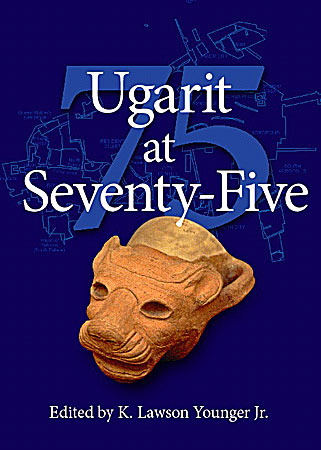Ugarit at Seventy-Five
Edited by K. Lawson Younger Jr.
In the spring of 1928, a Syrian farmer was plowing on the Mediterranean coast near a bay called Minet el-Beida. His plow ran into a stone just beneath the surface. When he examined the obstruction, he found a large man-made flagstone that led into a tomb, in which he found some valuable objects that he sold to a dealer. Little did he know what he had discovered. In April of 1929, C. F. A. Schaeffer began excavation of the tombs, but a month later he moved to the nearby tell of Ras Shamra. On the afternoon of May 14, the first inscribed clay tablet came to light—thus the beginnings of the study of Ugarit and the Ugaritic language. Seventy-five years have passed, and the impact of this extraordinary discovery is still being felt. Its impact on biblical studies perhaps has no equal. In February 2005, some of the preeminent Ugaritologists of the present generation gathered at the Midwest Regional meetings of the American Oriental Society to commemorate these 75 years by reading the papers that are now published in this volume. The first five essays deal with the Ugaritic texts, while the last three deal with archaeological or historical issues.
- Description
- Table of Contents
In the spring of 1928, a Syrian farmer was plowing on the Mediterranean coast near a bay called Minet el-Beida. His plow ran into a stone just beneath the surface. When he examined the obstruction, he found a large man-made flagstone that led into a tomb, in which he found some valuable objects that he sold to a dealer. Little did he know what he had discovered. In April of 1929, C. F. A. Schaeffer began excavation of the tombs, but a month later he moved to the nearby tell of Ras Shamra. On the afternoon of May 14, the first inscribed clay tablet came to light—thus the beginnings of the study of Ugarit and the Ugaritic language. Seventy-five years have passed, and the impact of this extraordinary discovery is still being felt. Its impact on biblical studies perhaps has no equal. In February 2005, some of the preeminent Ugaritologists of the present generation gathered at the Midwest Regional meetings of the American Oriental Society to commemorate these 75 years by reading the papers that are now published in this volume. The first five essays deal with the Ugaritic texts, while the last three deal with archaeological or historical issues.
Preface
Abbreviations
Recent Study of Israelite Religion in Light of the Ugaritic Texts Mark S. Smith
Preliminary Presentation of a New Ugaritic Song to ʿAṯtartu (RIH 98/02) D. Pardee
The Religious Role of the King at Ugarit Nicholas Wyatt
Just How Many Monsters Did Anat Fight (KTU 1.3 III 38–47)? Wayne T. Pitard
Ugarit and the Bible: New Data from the House of Urtenu Pierre Bordreuil
Ugarit: The Kingdom and the City—Urban Features Yves Calvet
Arrowheads from Iron Age I: Personal Names and Authenticity Richard S. Hess
The Late Bronze Age / Iron Age Transition and the Origins of the Arameans K. Lawson Younger Jr.
Indexes
Mailing List
Subscribe to our mailing list and be notified about new titles, journals and catalogs.




